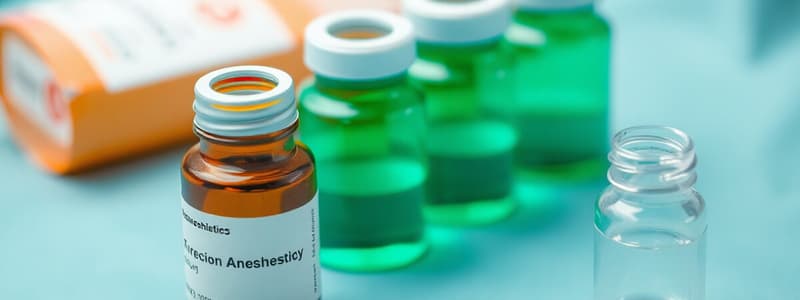Podcast
Questions and Answers
Which organ systems are primarily affected by the toxicity of local anaesthetics?
Which organ systems are primarily affected by the toxicity of local anaesthetics?
- Digestive System and Muscular System
- Endocrine System and Lymphatic System
- Respiratory System and Skin
- Central Nervous System and Heart (correct)
What factor significantly influences the rate of absorption of local anaesthetics into the systemic circulation?
What factor significantly influences the rate of absorption of local anaesthetics into the systemic circulation?
- Duration of anaesthetic effect
- Type of local anaesthetic used
- Body temperature of the patient
- Vascularity of surrounding structures (correct)
What happens to local anaesthetics once the plasma is saturated?
What happens to local anaesthetics once the plasma is saturated?
- They become non-effective and cease function.
- They are metabolized more efficiently.
- They are expelled from the body faster.
- The level of free drug in the systemic circulation rises rapidly. (correct)
What is a significant consequence of high binding of local anaesthetics to plasma?
What is a significant consequence of high binding of local anaesthetics to plasma?
Which condition can hinder the metabolism of local anaesthetics in the body?
Which condition can hinder the metabolism of local anaesthetics in the body?
What is LAST in the context of local anaesthetic toxicity?
What is LAST in the context of local anaesthetic toxicity?
Which type of metabolism occurs when the body fails to generate sufficient ATP for metabolizing local anaesthetics?
Which type of metabolism occurs when the body fails to generate sufficient ATP for metabolizing local anaesthetics?
How do local anaesthetics affect nerve impulses in the brain?
How do local anaesthetics affect nerve impulses in the brain?
What is the primary reason local anaesthetics are administered?
What is the primary reason local anaesthetics are administered?
How do local anaesthetics primarily achieve their effect on pain signaling?
How do local anaesthetics primarily achieve their effect on pain signaling?
What characteristic of local anaesthetics allows them to cross cell membranes effectively?
What characteristic of local anaesthetics allows them to cross cell membranes effectively?
What is a potential consequence of the use of local anaesthetics regarding heart function?
What is a potential consequence of the use of local anaesthetics regarding heart function?
Which factor contributes to the risk of toxicity associated with local anaesthetics?
Which factor contributes to the risk of toxicity associated with local anaesthetics?
What electrolyte is essential for muscle contraction and nerve cell transmission that local anaesthetics affect?
What electrolyte is essential for muscle contraction and nerve cell transmission that local anaesthetics affect?
When do symptoms of local anaesthetic systemic toxicity usually appear?
When do symptoms of local anaesthetic systemic toxicity usually appear?
What type of structure does a local anaesthetic need to have to effectively block nerve impulses?
What type of structure does a local anaesthetic need to have to effectively block nerve impulses?
What is the first recommended step in treating local anaesthetic systemic toxicity (LAST)?
What is the first recommended step in treating local anaesthetic systemic toxicity (LAST)?
What is the purpose of lipid emulsion in the treatment of LAST?
What is the purpose of lipid emulsion in the treatment of LAST?
What is a potential consequence of prolonged PR intervals in a patient?
What is a potential consequence of prolonged PR intervals in a patient?
Why is it important to administer 100% oxygen in LAST treatment?
Why is it important to administer 100% oxygen in LAST treatment?
What should be done if there is a decline in the level of consciousness during LAST?
What should be done if there is a decline in the level of consciousness during LAST?
What role does lipid emulsion play in improving cardiac function during LAST?
What role does lipid emulsion play in improving cardiac function during LAST?
What is a sign of severe progression in cases of prolonged PR intervals?
What is a sign of severe progression in cases of prolonged PR intervals?
What intervention should be taken during an emergency treatment for LAST?
What intervention should be taken during an emergency treatment for LAST?
What is an initial symptom that can occur due to blockade in the brain caused by local anesthetics?
What is an initial symptom that can occur due to blockade in the brain caused by local anesthetics?
Which process is inhibited in cardiac tissue due to local anesthetics?
Which process is inhibited in cardiac tissue due to local anesthetics?
What happens when the production of ATP is stopped by local anesthetics?
What happens when the production of ATP is stopped by local anesthetics?
What can excessive accumulation of H+ ions in the body lead to?
What can excessive accumulation of H+ ions in the body lead to?
Which ion channel blockade leads to conduction defects in the heart?
Which ion channel blockade leads to conduction defects in the heart?
What is one consequence of reduced ATP transportation capability in cardiac cells?
What is one consequence of reduced ATP transportation capability in cardiac cells?
How can local anesthetics affect the cardiac cycle through ion channels?
How can local anesthetics affect the cardiac cycle through ion channels?
What could be a potential consequence of cardiac toxicity from local anesthetics?
What could be a potential consequence of cardiac toxicity from local anesthetics?
Flashcards
Local Anesthetic Systemic Toxicity (LAST)
Local Anesthetic Systemic Toxicity (LAST)
A life-threatening event that can occur after administering a local anesthetic, regardless of the administration route.
Lipophilic
Lipophilic
A general term for a substance that dissolves easily in fats or lipids.
Chemical Structure of Local Anesthetics
Chemical Structure of Local Anesthetics
Local anesthetics are made up of water-soluble salts combined with lipid-soluble alkaloids. This structure allows them to cross cell membranes easily in their unionized form.
Mechanism of Action of Local Anesthetics
Mechanism of Action of Local Anesthetics
Signup and view all the flashcards
Role of Sodium in the Body
Role of Sodium in the Body
Signup and view all the flashcards
How Does Systemic Toxicity Happen?
How Does Systemic Toxicity Happen?
Signup and view all the flashcards
Lipid Solubility of Local Anesthetics
Lipid Solubility of Local Anesthetics
Signup and view all the flashcards
Rapid Early Depolarization
Rapid Early Depolarization
Signup and view all the flashcards
Local Anesthetic Toxicity
Local Anesthetic Toxicity
Signup and view all the flashcards
LA Absorption Rate
LA Absorption Rate
Signup and view all the flashcards
LA and Plasma Binding
LA and Plasma Binding
Signup and view all the flashcards
LA Plasma Binding Affinity
LA Plasma Binding Affinity
Signup and view all the flashcards
Plasma Saturation and Toxicity
Plasma Saturation and Toxicity
Signup and view all the flashcards
Tissue Perfusion and LA Toxicity
Tissue Perfusion and LA Toxicity
Signup and view all the flashcards
LA Metabolism
LA Metabolism
Signup and view all the flashcards
LAST and Mitochondrial Function
LAST and Mitochondrial Function
Signup and view all the flashcards
Initial Excitation Caused by LA in the Brain
Initial Excitation Caused by LA in the Brain
Signup and view all the flashcards
LA-Induced Seizures and CNS Depression
LA-Induced Seizures and CNS Depression
Signup and view all the flashcards
LA Impact on Mitochondrial Function
LA Impact on Mitochondrial Function
Signup and view all the flashcards
LA's Effects on Heart Function
LA's Effects on Heart Function
Signup and view all the flashcards
LA Blocking Ion Channels in the Heart
LA Blocking Ion Channels in the Heart
Signup and view all the flashcards
LA's Impact on Sodium, Potassium, and Calcium Channels
LA's Impact on Sodium, Potassium, and Calcium Channels
Signup and view all the flashcards
LA's Effect on Heart Conduction and EKG
LA's Effect on Heart Conduction and EKG
Signup and view all the flashcards
LA-Induced Acidosis and Anaerobic Metabolism
LA-Induced Acidosis and Anaerobic Metabolism
Signup and view all the flashcards
Prolonged PR Interval
Prolonged PR Interval
Signup and view all the flashcards
Cardiac Arrest in LAST
Cardiac Arrest in LAST
Signup and view all the flashcards
Rapid Early Depolarization (Action Potential)
Rapid Early Depolarization (Action Potential)
Signup and view all the flashcards
Lipid Emulsion Therapy for LAST
Lipid Emulsion Therapy for LAST
Signup and view all the flashcards
Mechanism of Lipid Emulsion in LAST
Mechanism of Lipid Emulsion in LAST
Signup and view all the flashcards
Intralipid in LAST Treatment
Intralipid in LAST Treatment
Signup and view all the flashcards
Oxygen Therapy in LAST
Oxygen Therapy in LAST
Signup and view all the flashcards
Study Notes
Local Anaesthetic Systemic Toxicity (LAST)
- Life-threatening adverse event following local anesthetic administration
- Symptoms usually appear within 10 minutes, but can occur within an hour
- Local anesthetics are water-soluble salts of lipid-soluble alkaloids (lipophilic) allowing them to easily cross cell membranes
- They target voltage-gated sodium channels, blocking sodium channels and interfering with signals to the brain
- Rapid early depolarization stage is prevented
- Different anesthetics have varying lipid solubility, impacting toxicity risk
- Local anesthetics can lead to mild or life-threatening effects (e.g. seizures, cardiac arrest) in the central nervous system (CNS) or heart
Why Local Anesthetics?
- Used to numb an area, preventing pain signals from reaching the brain
- Lipophilic structure allows them to easily cross cell membranes and spread through the tissues
- Different anesthetics have different lipid solubility levels, influencing their speed and ease of removal
How Systemic Toxicity Happens?
- Local anesthetic concentration reaches a level affecting sodium-dependent organs (mostly nervous system tissues in the heart and CNS)
- Absorption into systemic circulation depends on the amount administered and the vascularity of the area
Systemic Toxicity Causes and Effects (Brain)
- Local anesthetics readily cross the blood-brain barrier
- Blockage of sodium channels disrupts nerve impulse transmission to the brain
- Initial excitation (nervousness, confusion, agitation) followed by CNS depression, decreased consciousness, and potentially respiratory arrest
Systemic Toxicity Causes and Effects (Heart)
- Local anesthetics affect cardiac tissue by blocking ion channels and hindering oxidative phosphorylation in mitochondria
- Inhibition of ATP production reduces energy for cardiac function
- A build-up of H+ ions could lead to cell death and organ damage
- This event can cause hypotension, bradycardia, arrhythmias and ultimately cardiac arrest
Prevention of LAST
- Use ultrasound guidance during administration for better accuracy and to avoid intravascular injection
- Administer the lowest effective dose
- Gentle aspiration prior to each injection to confirm non-intravascular placement
- Administer incrementally (3-5ml aliquots), pausing between each aliquot
- Monitor and manage blood pressure, heart rate, and other relevant vitals for signs of toxicity
Treatment of LAST
- Discontinue the local anesthetic if possible
- Emergency lipid rescue pack (e.g. Intralipid) to remove the anesthetic from the tissues
- High oxygen concentrations (100% O2) and ensure adequate ventilation
- Intravenous access for fast treatment with the lipid emulsion
- Monitor and treat hypotension and arrhythmias as needed
Important Considerations
- Intravascular markers indicating the presence of local anesthetic in the bloodstream are important for dose adjustments and decisions
Extra Considerations
- Metabolism and function of enzymes in the plasma play a crucial role in the rate at which local anesthetics are eliminated from the body
- Correct use of benzodiazepines can be crucial for management of severe cases of LAST
Studying That Suits You
Use AI to generate personalized quizzes and flashcards to suit your learning preferences.




